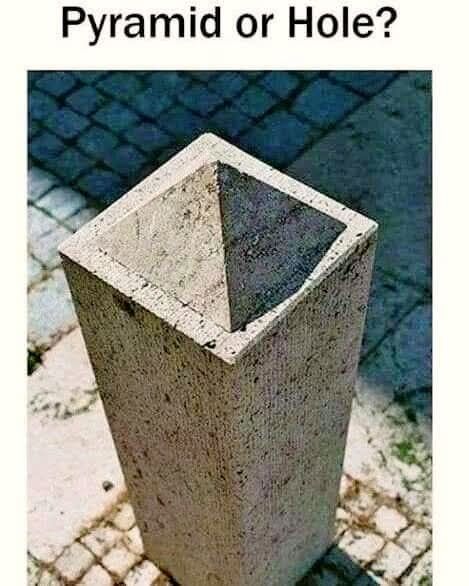In the age of social media, optical illusions have a way of going viral and stirring up debates across comment sections. One image in particular has puzzled thousands with a simple yet tricky question: “Pyramid or Hole?” At first glance, it looks straightforward. But the more you stare, the more your brain starts to question what it’s actually seeing. So what’s the truth behind the illusion?

A Closer Look at the Image
The photo shows a rectangular stone pillar standing upright, with a triangle-shaped structure carved or placed at the top. That triangle is where the confusion begins. To some, it looks like a pyramid sticking out of the surface. To others, it seems like a triangular hole going inward.
This subtle shift in perspective plays tricks on the brain — making it tough to tell whether the shape is popping out or caving in.
Video: 99.99% Of People Will Fail 🤦🏻 || Brain Test || CatchyMindset
Analyzing the Lighting and Shadows
To solve the puzzle, we have to look beyond the shape itself — and focus on the lighting and shadows.
Notice the overall light direction in the image: it’s coming from the top left. The left side of the stone pillar is well-lit, while the right side is shaded, confirming the angle of the light source.
Now, look inside the triangular area. The left side of the triangle is bright, while the right side is darker — matching the same lighting pattern as the outside of the pillar.
If this were a hole, the far side of the cavity (which would be facing the light) should be brighter, and the near side (closer to the viewer) would likely be darker. But that’s not what we see. Instead, the shadowing is consistent with a shape sticking out — a pyramid, not a hole.
Video: Pyramid Or Hole What is This 99% Fail.
The Correct Answer: It’s a Pyramid
Based on the direction of the light and how the shadows fall, there’s only one logical conclusion: the triangular shape is a raised pyramid, not a hole.
This illusion works because our brains are wired to process depth, lighting, and perspective in familiar ways. But sometimes, when those visual cues are arranged cleverly, we get fooled — just like here.
The triangle tricks the eye into flipping between two interpretations, but when you break it down logically, the lighting reveals the truth.
Conclusion
The “Pyramid or Hole?” illusion is more than just a fun brain teaser — it’s a fascinating example of how easily our perception can be misled. By paying close attention to the light source and shadows, we can confidently say that the shape on top of the pillar is a pyramid sticking upward, not a hole dug into the stone.
So next time you see an optical illusion like this, don’t just trust your first instinct. Take a second look. Because in the world of visual tricks, what you see isn’t always what you get.